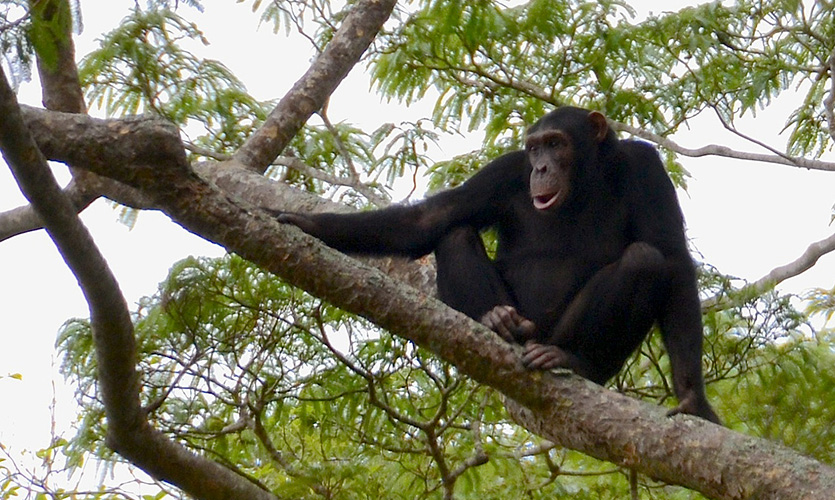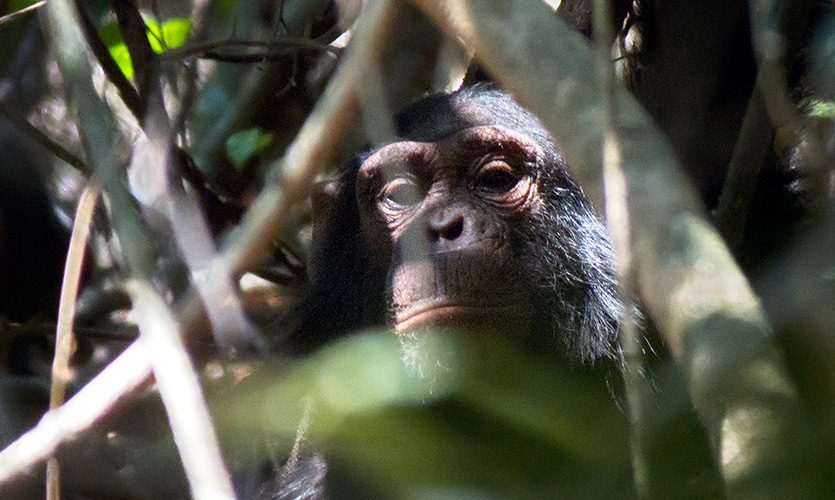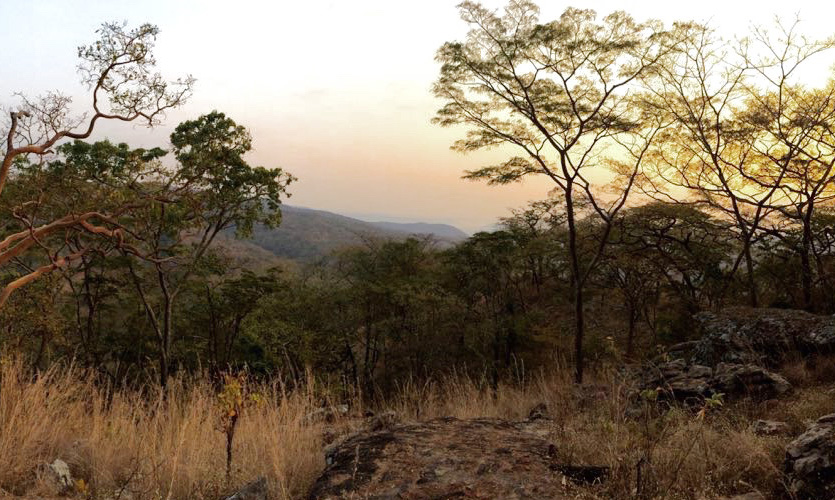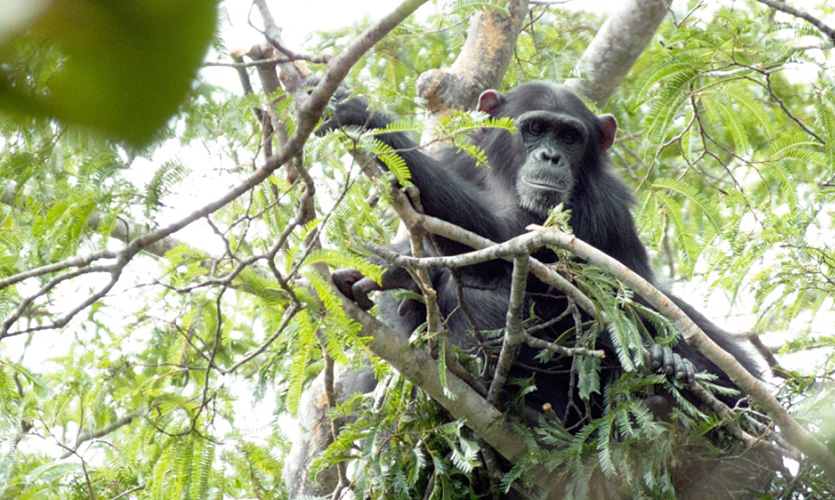The life of a primatologist
The life of a primatologist

From PG Tips adverts to Bubbles, there’s one species of primate that arguably captures our imagination more than others – the beloved chimpanzee. But behind the endearing personas created by marketers and the media lie potential secrets to our own backstory and a conservation challenge that doesn’t show signs of easing.
We talk to LJMU primate specialist and lecturer in Animal Behaviour, Dr Alex Piel about his research on these remarkable cousins of ours.
 Can you tell us a bit about your research?
Can you tell us a bit about your research?
My research focuses on the primates of the Issa Valley, in the western region of Tanzania. It is one of the driest, most open and seasonal habitats where chimpanzees live. With Fiona Stewart, I co-direct the Greater Mahale Ecosystem Research and Conservation Project, which is based at a remote location in the middle of chimpanzee habitat. I’m particularly interested in primate vocalisation and primate adaptations to a savanna-woodland environment – the environment that characterises the entire region of western Tanzania.
How are the chimpanzees helping us to learn more about our own ancestors?
The arid, open environment where Issa’s chimpanzees live is similar to how we reconstruct that in which our early ancestors would have lived. By studying chimpanzee adaptations to this environment we can understand much about our own origins. Around 6-7 million years ago, when our ancestors moved from the closed, wet tropical forests into open, dry savanna mosaics, their feeding and grouping behaviour likely changed. They were confronted with new challenges, both ecological and social. We’re learning that these open-habitat chimpanzees exploit food sources in various vegetation types but only at certain times of year; that they encounter and have to evade predators like wild dogs that don’t exist in the forests; and that their social organisation likely relies on long-distance calling to reunite widely-spaced groups. All of these are likely to be the same types of solutions that early hominins exhibited millions of years ago.
Why didn’t chimpanzees evolve in the same way as humans?
Each species has its own evolutionary history, each its own strategy. Millions of years ago, when there was neither chimpanzees nor humans, there was a divergence and from that event, multiple lineages emerged from which very few survive today: one human and two chimpanzee (bonobos and chimpanzees).
What made you want to study chimpanzees?
I have always been driven, not just to study chimpanzees, but to understand how animals survive in marginal habitats and how that informs our understanding of our own evolutionary trajectory. As an endangered species living predominantly outside of protected areas, chimpanzees face dwindling habitat that is in need of protection. Thus, along with research into their behaviour, my challenge is to integrate my work into conservation strategies for chimpanzees and their critical environment. These are priorities for anyone interested in wildlife and wild areas.
How close to the chimpanzees do you get?
Chimpanzees take five to eight years to get used to humans (habituate) so it was important to ensure that there was long-term funding in place at Issa before we decided to commit to habituation efforts, otherwise our abandonment of the area (when funding was exhausted) would leave them vulnerable to poachers.
Some chimpanzees are now comfortable with researcher presence, with encounters up to six hours not uncommon. The difficulty is that once a group gets used to the researchers, the next time we visit the observation space, another chimpanzee group will enter that aren’t used to us. The process requires tremendous time, patience, and determination.
Males are typically the first to habituate and there are four or five males that the research team know as individuals now. The research team stay a safe distance of 25 metres from any chimpanzee, which is a good distance to observe them with binoculars and still keep them disease free – a human flu could potentially wipe out a population – and also keep them wary of humans.

Credit: UPP/Ed McLester
If you can’t find a group of chimpanzees to study on a given day, what do you do?
We don’t always have access to the chimpanzees so we use other means to study them such as studying their vocalisations, collecting faeces to determine what they are eating, and studying their nest making. We have motion triggered cameras distributed around the study area to capture their activities in our absence. We also collaborate closely with Prof. Serge Wich, Professor of Primate Biology and Conservation at LJMU, to use drones to study chimpanzee habitat. Drones allow us to study vast areas that researchers would take weeks to cover and terrain that would be difficult to access such as the tree canopy for studying nest architecture. Plus drones allow us to get real-time data.
How does the project contribute to conservation?
The land where we work is not under any formal protective status – it’s considered “general land” – and with chimpanzees at very low density (there are not as many as tropical forests, for example), it is challenging to persuade conservationists of the value of this region. We partner with local and also international organisations, especially the Jane Goddall Institute and The Nature Conservancy, that specialise in conservation practice; we concentrate on gathering data, especially on chimpanzee presence, abundance and distribution, sharing key findings with these organisations and governmental institutions who can then enact change on a policy level.
Additionally, we still play a direct role in chimpanzee conservation. Our presence alone has helped deter human activity such as hunting and snaring. Hunters avoid the core study area, fearful of being apprehended by our team, or else government rangers with whom we work closely, conducting joint patrols to monitor human (illegal) activity, removing snares and confiscating bush meat.

Credit: UPP/Adrienne Chitayat
During your time with the project have you seen changes in people’s attitudes towards the conservation of Tanzania’s chimpanzees?
This is difficult to answer at the local level, as our work is primarily at the district and national government level. At least at the government level, absolutely. I recently participated in a National Chimpanzee Conservation Management Planning workshop where the Tanzanian government made clear its dedication to protecting chimpanzees and their habitat. This level of commitment is critical to developing sustainable, long-term strategies for chimpanzee conservation. At the local level, people are wary of outsiders dictating policy and rightfully so. As a result, we work closely with all levels of government and can point to concrete steps that village and national governmental institutions have taken towards protecting chimpanzees, initially informed by our data, then subsequently fed into non-governmental and especially governmental channels for effective change to begin.
Can you tell us three things we might not know about chimpanzees?
- Unlike most mammals, but similar to humans, males remain in their natal group whilst females immigrate
-
They are remarkably socially fluid, with sub-groups of individuals coming together and splitting up sometimes by the hour. Only a few other species do this such as ourselves, dolphins, elephants…
- Their plight is urgent across Africa and each community of chimpanzee becomes more and more critical in an increasingly fragmented landscape that humans dominate

Credit: UPP/Ed McLester
Is there hope for the chimpanzee?
Yes, with concerted effort on both research and conservation fronts. My work continues to provide important data on chimpanzee distribution, conservation status and behaviour…helping us better understand what these apes need to survive and how we can adapt conservation practice to both human and chimpanzee needs. I remain encouraged by Tanzanian government and international support for this species.
Chimpanzees are long-lived animals and our knowledge and understanding of them requires similarly long-lived commitment. Support for this work is scarce and competitive and often it is the animals themselves that are the victims of funding and international politics. I urge those who want to contribute to get in touch with our project and inquire about ways to help. Chimpanzees inform us about our evolutionary roots as humans but simultaneously their survival reflects how we view our future. Ongoing habitat degradation and destruction will inevitably hurt species of all types and thus our conservation and sustainability strategies must find ways to address needs across species-boundaries.
|
LJMU’s Primate Behaviour and Conservation MSc students have participated in a field course, led by Piel and hosted by the Greater Mahale Ecosystem Research and Conservation Project, which took them to the wilds of Tanzania. Find out about their experiences. Visit the Greater Mahale Ecosystem Research and Conservation Project website to find out more about the research. |



